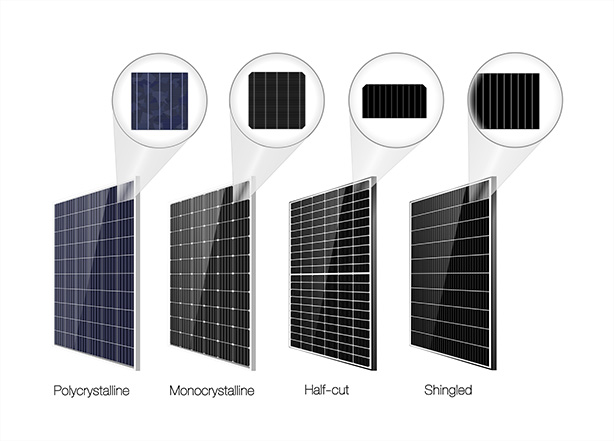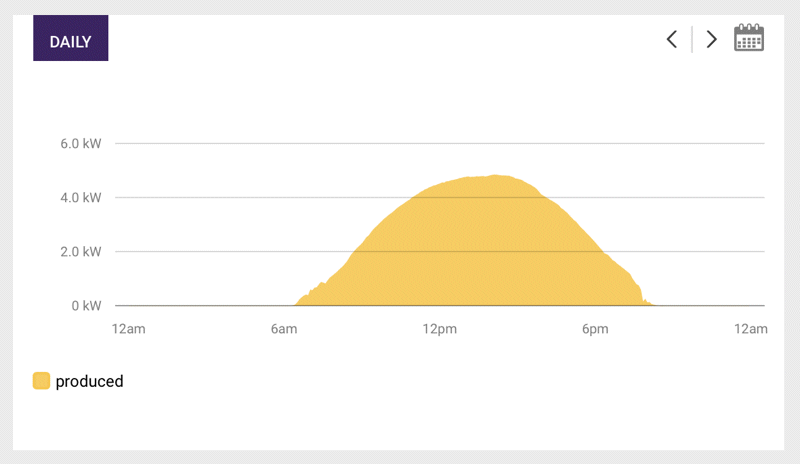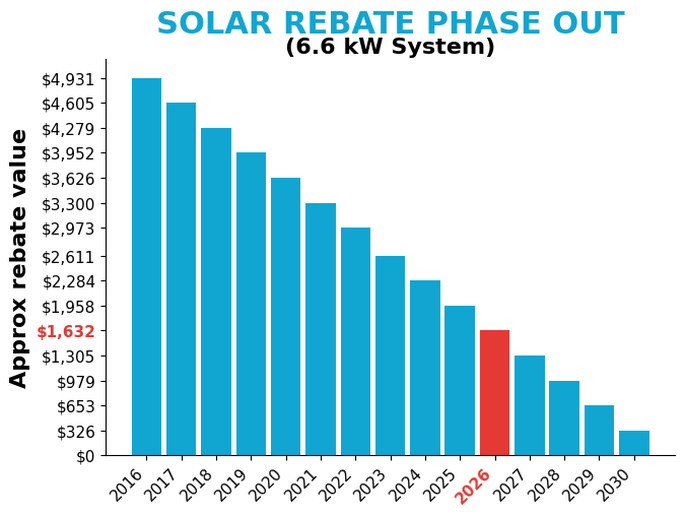SOLAR 101: BUYING SOLAR POWER – 2026 EDITION
By Finn Peacock
Chartered Electrical Engineer, ex-CSIRO, Founder of SolarQuotes.com.au
Last Updated: 2nd Jan 2026
After reading this guide, you’ll know more about solar energy than most Australians, be able to go toe-to-toe with a solar salesperson, and be confident you’re paying the right amount of money for a properly-sized residential solar power system installation for your home in 2026.
Would you prefer to print this guide? Click here for printer-friendly PDF version.
This cheat-sheet is for you if you are thinking of investing in solar power.
Part 1 of my Solar 101 series covered understanding solar power and the rest of this website contains lots more information on everything you could need to know about solar energy and installation. But there is so much information on my website it can feel a little like tumbling down a rabbit hole.
That’s why I created this Solar 101 buying guide, which should take you about 15 minutes to read.
Pro-tip: Are you a commercial property owner? read my Commercial Solar 101 Guide – it’s written specifically for businesses.
If you’re feeling confident about residential solar power systems already and you’re looking to get quotes from quality pre-vetted Australian installers I trust, click here.
Otherwise, here’s what you should know before you get quotes for solar power and proceed with buying a system and arranging installation:
- The four main components of a solar power system.
- A good solar installation is critical.
- The basics of roof direction/angle for optimal solar electricity generation.
- Understanding how your home uses solar energy.
- How many solar panels should you buy?
- The solar rebate: still very much alive and kicking and generous.
- What price range can you expect to pay for quality solar power?
- How to calculate the savings and payback of a solar system
- Batteries – do you need them?
- How are you planning on paying for your system? Understanding finance.
- Remote inverter shutdowns and a “solar tax” – scary sounding, but benign.
- The next step.
Beginners Note: kWh stands for ‘kilowatt-hour.’ It is a unit of energy. It measures how much electricity is used over time. A typical Australian home uses 16-25 kWh of electricity per day.
Email: [email protected]
Tel: 08 7200 0177
Snail Mail: 3/39 Grenfell St, Adelaide, SA 5000 Australia
#1 The four main components of a solar power system
There are four main parts of a home solar power system:
- Solar panels
- Solar inverter
- Racking/mounting
- Monitoring
Let’s go into more detail for each.
Component #1: Solar panels
Solar panels consist of a grid of solar cells under a sheet of extremely tough glass protected by a frame. Panels sit on your roof and convert sunlight into DC electricity. Panels can use different cell types and cell arrangements:
The vast majority of panels sold these days are ‘monocrystalline half-cut’ panels. These first appeared around 10 years ago because solar panels can be a little more efficient and shade-tolerant if square solar cells are cut in half. They work so well they’ve pretty much taken over the market.
Pro-tip: There are some benefits to using half-cut or shingled panels over conventional ones if you have shade that creeps up on the solar panels through the day. Otherwise, don’t stress – any cell arrangement will work well.
It doesn’t really matter what kind of solar cell technology your panels use.
What matters most is that you get a good brand with a solid Australian support team.
Solar Panel Brands
Now, you probably don’t know a good solar panel brand from a bad one. And why should you?
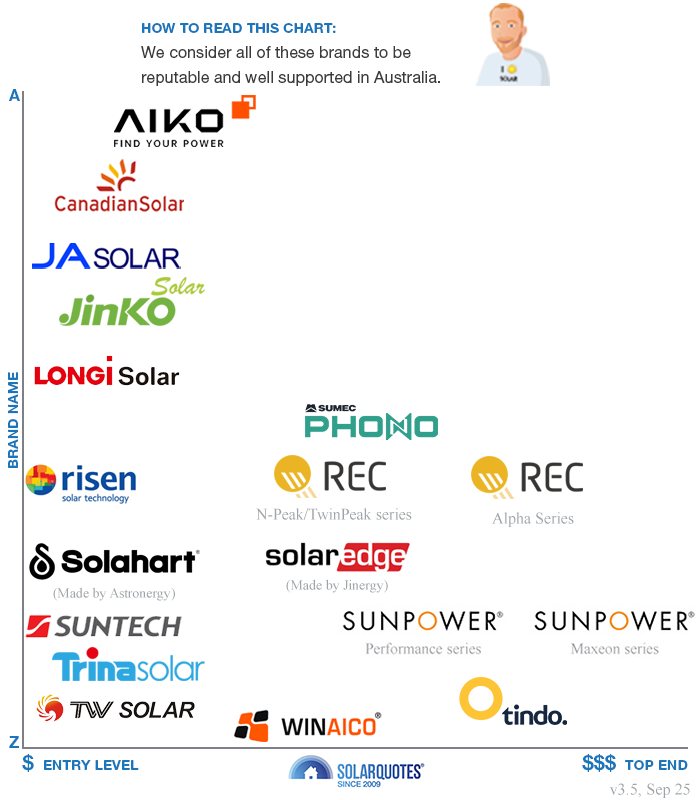
If you want to play it safe, stick to the brands on this chart! See the criteria developed for the chart here. Note: SolarQuotes does not take incentives from manufacturers to promote or give their solar panel brand preference.
This list is not exhaustive – if you’re not sure about a brand, shoot me an email. Be aware that my reply will most likely be, “play it safe and stick to a brand on my chart”!
Pro-tip: Find detailed reviews of each brand here: Risen | Trina | Jinko | Phono | Aiko | Canadian Solar | Suntech | TW Solar | Sunpower | REC | JA Solar | Tindo | Longi | Winaico
To get an idea of how buying premium panels will affect your budget, going for a high-end brand such as REC over a budget-end brand like Jinko can add about 30% to the total system cost.
The difference in *performance* between budget and premium brands is marginal. The main difference between the two is:
- How much their energy output will degrade over the years.
- The length of their product warranty — although many cheaper brands have caught up and now offer 25 or 30 years.
For example, 440W Jinko Tiger Neo solar panels are warranted to have 89.6% of their rated output after 25 years and have a 25-year product warranty.
Top-end 460W REC Alpha Pure-R panels are warranted to have 92% of their rated output after 25 years, with a 25-year product warranty.
But the REC costs considerably more than the Jinko panel. Is that slower performance degradation worth the extra price? That’s a decision for you to make.
Component #2: Solar Inverter
The second main component of a home solar power system installation is the inverter. They come in two main flavours:
- A string inverter, which is around the size of a piece of carry-on luggage
- Microinverters, which are around the size of a paperback book.
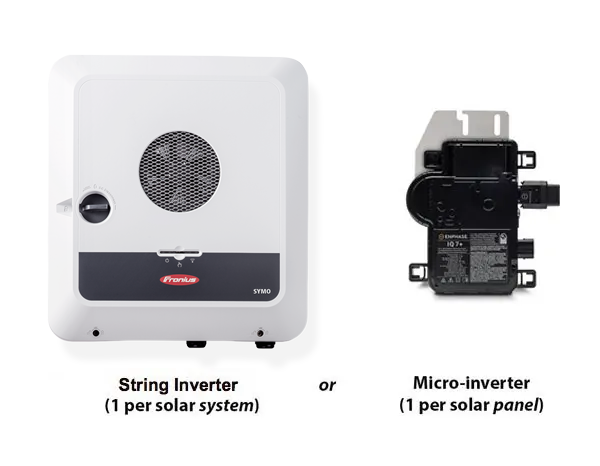
Microinverters cost more than string inverters, but bring a number of benefits
String inverters go on a wall, and all the solar panels connect to it. Microinverters go on the back of each solar panel.
There’s also a third option – ‘power optimizers’. These are a hybrid of the two. An optimizer system has both a string inverter on the wall *and* optimizers beneath each panel – or just some of the panels.
Microinverter and optimizer systems have some benefits over string inverter systems, mainly around design flexibility for awkward roofs.
But one of the core benefits spruiked by salespeople is around how they handle shade better than string systems. This may be partly true for budget-end string systems; but high-end string systems have advanced algorithms that these days that perform just as well in many shade situations.
One unique advantage of microinverters is that they operate at a lower voltage, which is safer if there’s a fault in the installation. But this can be mitigated by choosing a good installer (see below) and getting an inspection every 5 years.
You can read about the pros and cons of each inverter choice in detail here.
Pro-tip: Never mount a string inverter where it will be in full sun. Choose a shaded spot, a cool garage, or ask the installer to build a simple shade cover over the inverter. Direct intense sunlight can kill inverters because it cooks them – and Australia’s sun is particularly harsh. Installing an inverter where it is exposed to direct sunlight may also void its warranty.
Solar Inverter Brands
Here’s a rundown of the inverter brands available in Australia I believe to be good quality and well-supported.
Again, this list is not exhaustive. But, any reputable installer has a 95% chance of quoting you one of these brands:
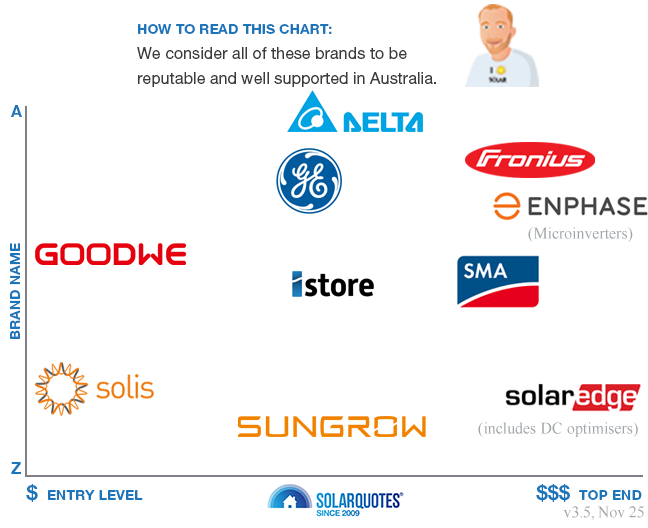
These are all inverter brands I’d be happy to install on my own house. You can view the criteria we developed for the chart here. Note: SolarQuotes does not take incentives from manufacturers to promote or give their solar inverter brand preference.
Pro-tip: Find reviews of each brand here: SMA | Fronius | Goodwe | SolarEdge | Delta | iStore | Sungrow | Enphase | Solis | GE | Sigenergy
The inverter is the component most likely to fail in the first 10 to 15 years. This is because they work hard all day and they do wear out. If your inverter fails, it will bring down your whole system unless you’re using micro-inverters.
So even if you’re on a limited budget, I’d recommend considering a mid-range or high-end solar inverter. I’m confident they’ll last longer than the cheapest ones. High-end inverters (like Fronius) cost about $1,200 more than budget-end ones (like Goodwe) for a 6.6kW system.
What about optimiser or microinverter based systems? For a 6.6kW solar system, expect to pay an extra $1,800 or more than what a budget inverter system would cost.
Component #3: Racking/mounting
What connects your solar panels to your roof? The racking.
There is a wide variety of racking brands out there. At the end of the day, racking is simply aluminium bolted together.
Most brands are much of a muchness, except for premium brands like Radiant. They provide more flexibility in the system’s design and may corrode less over decades.
The chart below shows brands we’re familiar with. The difference in price between a budget end brand and a premium end brand is around $100 per kilowatt.
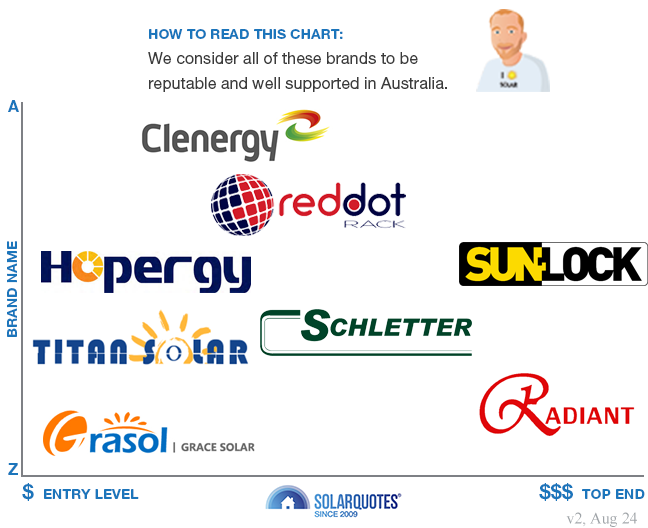
The main difference between racking brands is how easy they are for installers to work with, especially with difficult roofs. Note: SolarQuotes does not take incentives from manufacturers to promote or give preference to their racking brand.
Component #4: Consumption Monitor
Consumption monitors are small devices that sit in your switchboard. They cost around $500, and measure how much electricity is coming from or going to the grid.
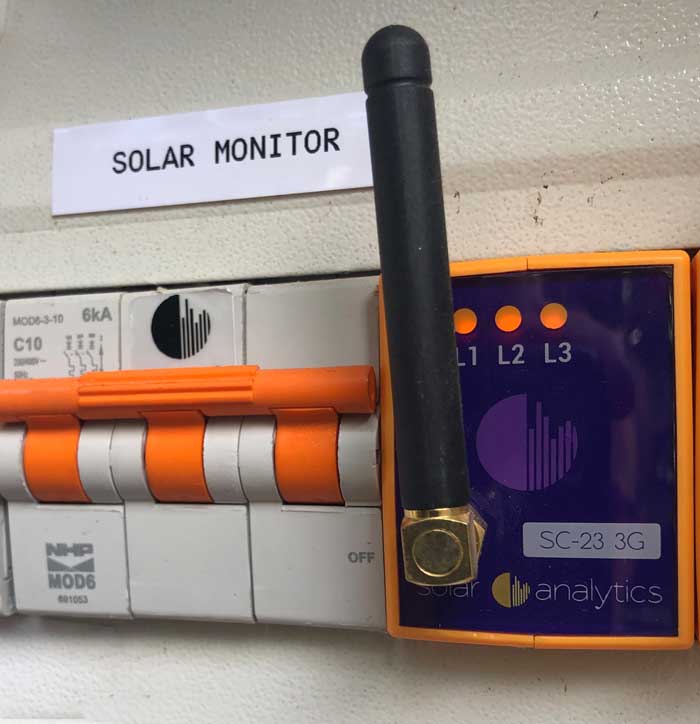
A consumption monitor in my switchboard.
To be clear – you can install a solar system without a consumption monitor. But I strongly recommend getting one. This is because inverters, out of the box, will only tell you how much solar energy your system is producing:
You’re blind as to how much energy your home is using – and when.
If you invest in a consumption monitor, your monitoring app will become much more useful. It will show both production and consumption:
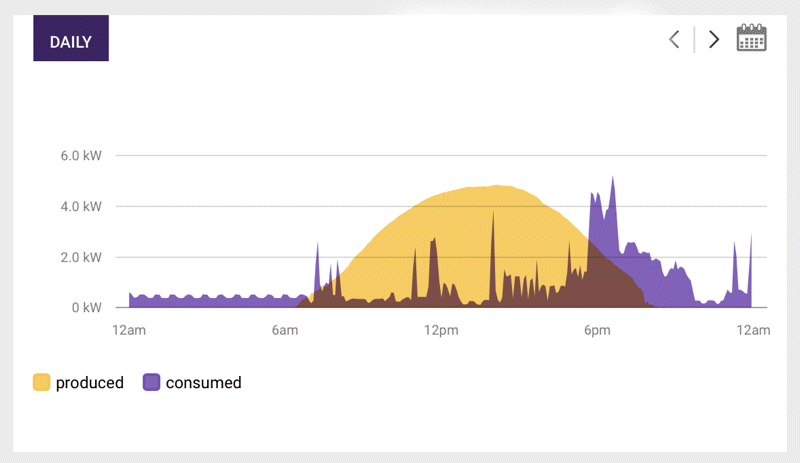
The purple area is the energy used by your home. The brown area is when your home is getting ‘free’ electricity from your solar power system.
This lets you easily see the best way to manage your energy use for maximum savings. I think the added insights you get from consumption monitors make them worth every dollar.
#2 A good solar installation is critical
A bad installer can take good brands – like the ones above – and make a dog’s breakfast of the installation.
Such systems not only look crap but can be unreliable, under-perform and be unsafe. Remember home solar systems can have up to 1,000 volts running through them. The install quality is critical.
To get a better understanding of how a great solar power system installation looks – click here.
If you are sourcing your own quotes, weed out bad installers by:
- Checking multiple review websites. Some reviews websites are easier to game than others.
- Look at the 1-star reviews. These tell you a lot about the true culture of the company. All companies make mistakes – but some companies make lots of really bad mistakes. Avoid them.
- Looking for consistency in ratings across Facebook, Google, SolarQuotes and other review sites. Look for a difference of less than 0.2 stars on their average ranking. Inconsistent average scores is a red flag they are gaming one site.
#3 The basics of roof direction/angle for optimal solar electricity generation.
Panel Direction
First – the absolute basics. The sun rises in the east and sets in the west.
This means:
- East-facing panels will generate more power in the morning.
- West-facing panels will generate more in the late afternoon.
- North-facing solar panels will generate the most energy overall, but less in the morning and late afternoon compared to east and west-facing panels respectively.
East and west-facing panels will produce about 15% less energy per year compared to north facing.
But – a working household can self-consume more solar energy with east and west-facing panels, because they produce more energy before and after school/work, accelerating their system’s payback compared to a north-facing one.
Sadly, I’ve spoken to more than one homeowner with a massive east or west roof ripe for harvesting solar energy who thinks it just isn’t worth it if their panels can’t face north.
It used to be true if you couldn’t install panels on a north-facing roof, then a home solar power system wasn’t worth it. Now that prices of solar power systems have dropped so much, you can get a fantastic return on investment from east or west-facing panels, or a combination of north, east and west.
Heck, despite what many well-meaning installers may claim, you can even get a good return with south-facing solar panels! South-facing systems produce about 30% less energy than a north-facing one – which, while not ideal, can still result in a sub-7 year payback.
On my own home, I have covered every roof space with panels, even my south-facing section.
Panel Angle
The ideal panel angle to maximize the energy produced over the whole year depends on your location:
| Canberra | Hobart | Darwin | Adelaide | Perth | Brisbane | Melbourne | Sydney |
| 33° | 38° | 19° | 32° | 29° | 29° | 33° | 33° |
So, for my house in Adelaide, the ideal solar panel angle is around 32° from horizontal.
If you’re not able to install your panels at the ideal angle, don’t worry too much. The solar panels in my own installation are at 15 degrees, and I only lose 4% in annual energy yield compared to the perfect angle.
Generally, unless your roof is flat, the ideal angle is whatever your roof is built at.
If your roof is flat, you can still install the panels flat – but you need to be aware that you’ll lose about 10% of your total annual generation, and you’ll need to pay someone to clean them frequently (around 3-4 times a year), as you need at least 10 degrees tilt for the rain to reliably run off the panels and clean them.
I recommend using tilt frames for a flat roof to avoid the lost generation and hassle of cleaning them.
Beginners Note: The best angle to mount your solar panels is the angle that your roof has been built at. The exception is flat roofs. If you have a flat roof you must either mount them on tilt frames so they self-clean in the rain, or mount them flat and be prepared to get them cleaned multiple times per year.
Pro-tip: If you have a flat roof and decide to use tilt frames, then consider East/West tilts. These allow you to fit more panels than north facing tilts and the structure can be simpler and cheaper.
Panel Orientation
Most rooftop solar panels installed in Australia are mounted in portrait orientation (the narrower sides top and bottom) for two reasons:
- It’s quicker
- It’s cheaper
Quicker and cheaper doesn’t always mean better, and that can apply here. Depending on your rooftop, it may be possible to install more capacity if the panels are installed in landscape orientation – but this will cost more and not just for the extra panels. I explain the pros and cons of portrait vs. landscape solar panel orientation here.
#4 Understanding how your home uses solar energy
Your home’s solar system installation will only ever operate in one of 2 modes:
Mode #1 Your system is generating more solar power than your home needs.
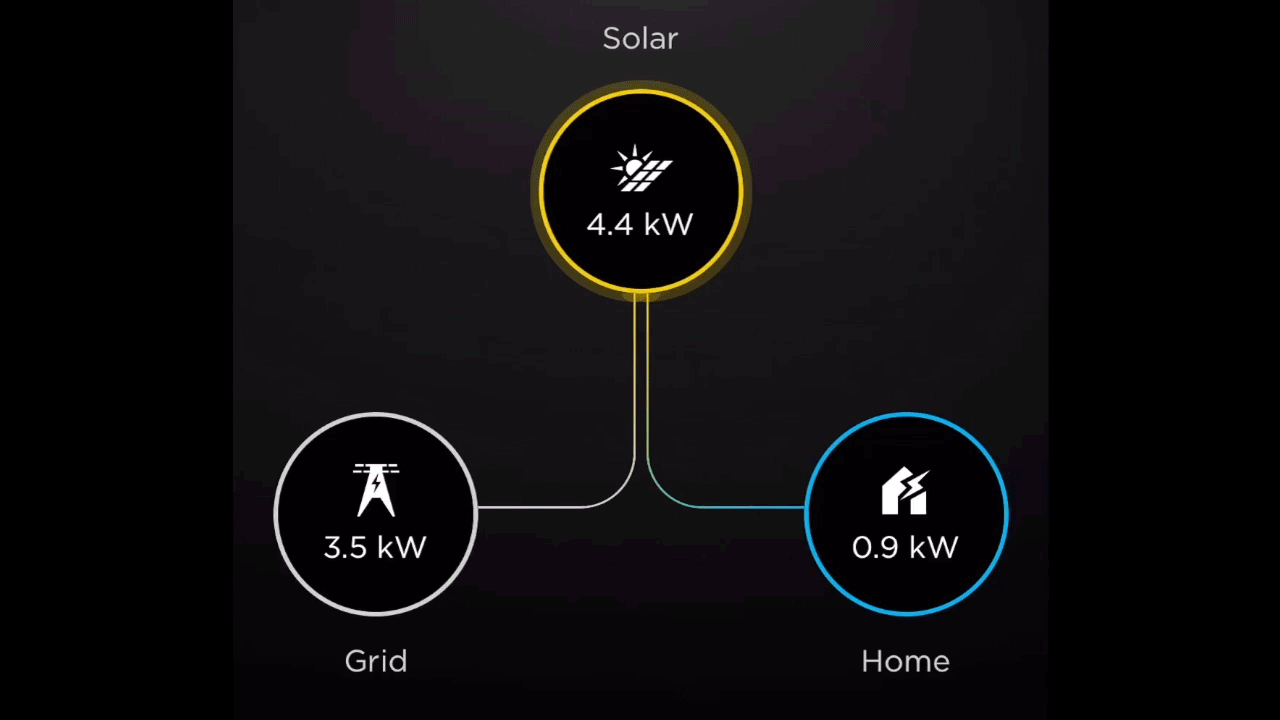
Credit: Tesla App
Here, my residential solar power system is producing 4.4 kW.
0.9 kW is going into my home, with the surplus 3.5 kW simply going into the grid.
My retailer pays me a ‘feed-in tariff’ for each kWh of solar energy I export. Depending on where you are in the country, feed-in tariffs can be anywhere from 2 – 12 cents per kilowatt hour.
Mode #2: Your home is using more power than your solar system is generating
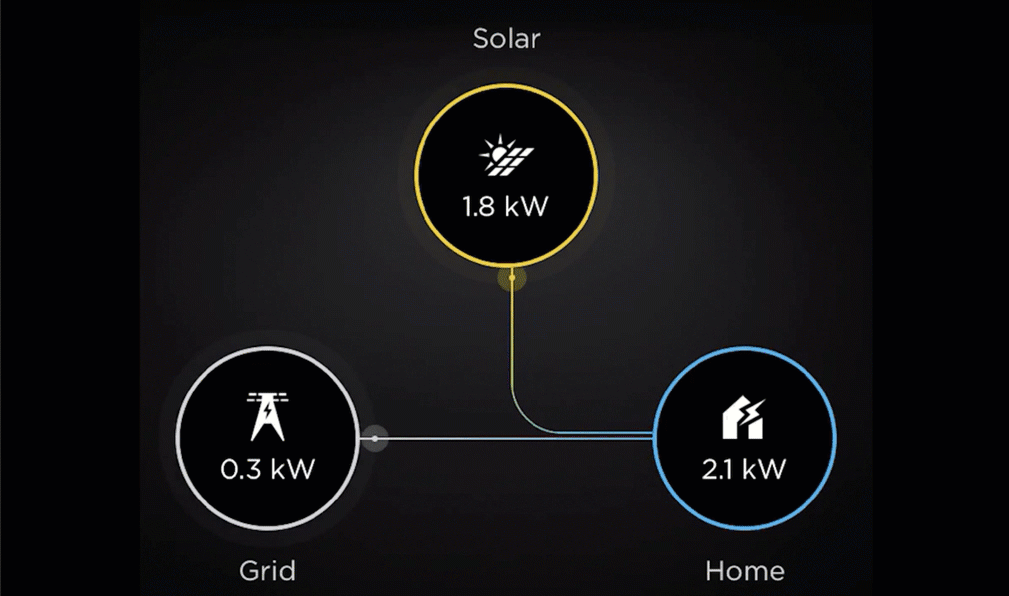
My home solar power system importing grid electricity because I’m not generating enough solar electricity at this point in time.
Here my home needs 2.1 kW of power, but my solar power system installation is only generating 1.8 kW. The grid simply tops up my home with the extra 0.3kW required. Obviously, you have to pay for any imported energy.
In Adelaide, I pay anywhere from 17 cents to 50 cents for grid electricity depending on the time of the day, and get 5 cents for exported solar energy. This means my self-consumed solar power is at least three times as valuable as exported solar electricity.
This is why I have my appliances set to run when the sun is out and don’t feel guilty when I switch on my aircon to pre-heat or pre-cool my house during the day, for a comfortable temperature at night.
#5 How many solar panels should you buy?
I get asked this question daily.
My answer is invariably: Install as much solar as you can reasonably fit and afford.
The maximum you can install depends on a few things, like available roof space and limits set by your local electricity network. A smart installer is a godsend here, as they will leverage the rules to get as much solar as possible on.
I’ve never heard a homeowner regret buying a large solar system. But I hear all the time from homeowners who wish they had installed more panels when they had the chance. Adding panels to an existing system is expensive and complicated.
Even if you “don’t need” a bigger residential solar system right now, you probably will in the future when you add a battery and an electric car to your home. If you buy a smaller system, you’ll likely be disappointed, especially when winter comes.
Upgrades
A few years ago, I upgraded my six kilowatt system to twenty kilowatts, so I could charge my two electric cars all through the year. I’d much rather pay a solar installer than an oil-baron for my fuel.
To fit as many panels as possible onto your roof, your installer may install them landscape (mentioned above) instead of the more common portrait. Generally, only good installers will offer this option as it is trickier (and thus more expensive) to install.
If you have a smaller, old system and want to upgrade, the best option economically is usually to remove the old panels and inverter and start again from scratch.
You’ll get the solar rebate on all the new panels – and if you put the old panels on Gumtree, some crazy off gridder will emerge from the woodwork to put your old panels to good use!
If you can’t bear the thought of ripping off your old system, you could do what I did – move my 10 year old system to my south-facing roof and put the shiny high-efficiency modern panels on the premium north facing roofspace. It cost me a couple of thousand to move the panels, but it makes me feel warm and fuzzy knowing they’ll continue to produce energy for many more years.
I’ve written about this topic in more detail here.
#6 The solar rebate: alive, kicking – and generous.
The famous Australian federal solar rebate, technically known as the SRES scheme, acts as a point of sale discount off a residential solar installation’s final cost.
All the prices you see advertised will already include this discount. It’s worth about $240 per kilowatt of solar panels installed in 2026, but this will vary slightly depending on where you live.
So, for example, 6.6 kW of panels attracts around $1,600 in rebates.
Anyone can claim the rebate, even if you’ve already bought solar power systems in the past and want to buy a new system.
The only restrictions on claiming the rebate are:
- Your system installation must be less than 100 kW in size (which is bloody big!).
- You get it installed and designed by a Solar Accreditation Australia (SAA) accredited professional (you can ask the installer on the day to provide proof of accreditation!)
- You use panels and solar inverters approved for installation in Australia by the Clean Energy Council (such as those I mentioned in my chart above).
The federal solar rebate is slowly being phased out. It reduces by one-fifth of today’s value every January until it goes to zero at the start of 2031.
For Victorians, there’s a state-level rebate that offers eligible recipients (up to) an extra $1,400 off the cost of a home solar system installation at the time of writing.
Pro-tip: The ‘federal rebate’ is based on solar panel capacity, not the inverter’s size. Panel capacity can be up to 133% of the inverter capacity and it makes sense to get close to this limit. (Having a battery installed at the same time can let you go over it.)
#7 What price range can you expect to pay for quality solar power?
As of January 2026, approximate prices for good quality solar panel systems in Australia, including full installation, are in the range of:
- 5 kW: $4,500 – $8,000
- 6.6 kW: $5,500 – $9,000
- 10 kW: $8,000 – $13,000
- 13.3 kW: $10,000 – $15,000
- 15 kW: $13,000 – $18,000
- 20 kW: $17,000 – $22,000
To be clear – the upper-end prices are for high-end residential system installations, installed by a solar energy ‘craftsman‘. Using absolute top-end gear – such as REC panels – will increase costs above the upper-end price ranges.
Note that the above prices also include the solar ‘rebate’ discount.
However, for those of you in Victoria, the above prices do not include the state-level rebate offered by the Victorian government (which provides a further rebate of up to $1,400).
Costs can increase if you need a switchboard upgrade or other electrical work is required to make your home suitable for a residential solar power installation, or if the design of your home makes the installation more difficult.
If you decide to install micro inverters or an optimiser-based system over a string inverter, costs will also increase by approximately 20%.
Installing battery storage (for an off-grid or hybrid system) will at least double the system’s price.
Pro-tip: Really cheap solar energy systems cost more in the long run, from repairs and lost output. I tell my friends to avoid these systems. It breaks my heart to see cheap solar panels go to landfill after a few years.
#8 How to calculate the savings and payback of a solar system
Exactly how much money solar power will save you depends on a few things:
- The size of your system, in kW
- The output of your home’s solar power system (which, when annualised, is very consistent!)
- Your ‘self-consumption ratio’. This is how much solar electricity you use in the home vs exports to the grid.
- Your feed-in tariff. These vary from retailer to retailer and state to state.
- Your usage tariff. This is what you pay for grid electricity.
The main way home solar power saves you money is by offsetting your grid electricity usage.
Let’s say you pay 36 cents per kWh, and your solar power system generates one kWh to offset that. You’ve just saved 36 cents.
But what if your system generates a kWh when your home does not need it? It’s sent to the grid, and your retailer pays you a feed-in tariff.
Using an example of 10 cents as a feed-in tariff paid by a retailer; that’s less than a third of 36 cents. So, in this example, self-consuming solar power saves more than three times as much as exporting it does.
Now, imagine being somewhere like Perth. In Perth, you can only get a feed-in tariff of 2c before 3 p.m. and pay 32c for grid electricity. In Perth, self-consumed solar energy is worth 16 times as much as exported solar electricity!
Here are some payback calculation examples for a 6.6 kW system. They’re taken from my solar calculator using its default settings as of January 2026.
- Adelaide: 4 years, 1 month
- Brisbane: 4 years, 3 months
- Canberra: 3 years, 11 months
- Darwin: 3 years, 9 months
- Hobart: 4 years
- Melbourne: 6 years, 5 months
- Perth: 5 years, 3 months
- Sydney: 4 years, 1 month
Pro-tip: Your circumstances will vary – make sure you calculate your own estimates if the payback is important to you.
Supercharging your return from home solar power
Want to save as much money as possible from your solar panels? Maximise your self-consumption.
Think – what’s running outside of daylight hours that you can put on a timer? Washing machines, dishwashers and pool pumps are some of the easiest wins.
Pro-tip: Avoid any solar energy company that calculates your solar system savings based on 100% self-consumption. Make sure you see the savings for more realistic scenarios such as 20% and 50% self-consumption.
#9 Batteries – do you need them?
Solar batteries are great for energy security. They can protect you from both your electricity retailer’s price rises and blackouts. Both of which seem to be getting worse!
The peace of mind you get from knowing that you will still have lights, refrigeration and other essential circuits, no matter what happens to the grid, can be priceless.
Pro-tip: Counter-intuitively, some battery systems will not provide backup when the grid goes down. If you want backup, you must specify this upfront, as it requires careful design and some rewiring of your switchboard.
A big enough battery and solar system also give you a similar peace of mind knowing that electricity prices going up and feed-in tariffs going down won’t really affect you.
A properly sized, correctly installed and configured solar battery can reduce your grid use by up to 95%, making you almost immune to electricity and feed-in tariff changes.
To be clear, no one knows which way electricity prices and feed-in tariffs will go. But if you have a battery, you won’t care.
The federal government launched a battery rebate worth around $330 per usable kWh of batteries installed. This helps a lot with battery economics, but it isn’t a panacea.
As electricity prices rise, feed-in tariffs fall, and more people get pushed onto time-of-use plans – batteries will pay back faster.
One myth I would like to bust about batteries is that “solar isn’t worth it without a battery”. Whilst your bills will be higher without a battery, a solar only home can still have great savings. It just means you have to be smart about what electricity plan you choose and shift as much consumption into the day as possible.
Certainly don’t wait for batteries to come down in price before buying solar panels.
Pro-tip: You don’t need to buy a special type of solar system to be ready for batteries. Every grid connect system ever installed in Australia is compatible with future batteries using a technique called ‘AC coupling’.
About Virtual Power Plants
One last thing on batteries – a recent phenomenon in the world of batteries is the Virtual Power Plant or VPP. In a nutshell, you can get a cheaper battery, monthly bill credit, or both, if you agree to let the VPP control it.
They will then be able to charge and discharge your battery to profit from electricity price fluctuations. But this can mean you’ll be left with a flat battery in the evening, as this is when VPPs will profit the most from controlling your battery.
In some states, VPPs can bring battery payback below ten years, but you do have to crunch your own numbers. Never take an electricity retailer or VPP operator’s word at face value.
A variation on the VPP that can accelerate your payback is provided by electricity retailers such as Amber. These guys expose you to the wholesale price of electricity for both your usage and your feed-in-tariff. That means, on rare occasions, you can get $15 or more per kWh for feeding into the grid. But be careful because you’ll also get slugged that much for using grid electricity in those periods.
If you have a battery, you can stack the odds in your favour by using the battery to avoid paying high prices while benefiting from high feed-in rates. In the past twelve months, I know of some people who have made a couple of thousand dollars by playing this game. But be warned! This type of plan is for advanced players only, and the savings are impossible to predict. Generally, battery owners will do better in volatile markets, but enter at your own risk! I don’t recommend these plans for solar-only households.
#10 How are you planning on paying for your system? Understanding finance.
Most Australians buy solar power systems with cash. If you are debt-free and have cash looking for a place to go, investing in a home solar system is worth serious consideration.
A solar power system installation currently generates a tax-free, reliable return that is far higher than bank interest rates or government bonds at the time of writing.
However, some of us don’t have the luxury of easy access to thousands of dollars. Many solar installers offer “no interest” finance – and if that sounds too good to be true, it’s because it probably is.
Some state governments—such as Victoria—offer genuine, taxpayer-subsidised, no-interest finance for part of the purchase price. For example, in VIC, the interest-free solar loan is only $1,400.
Otherwise, the solar installer has partnered with a “Buy Now Pay Later” (BNPL) company to finance the whole deal.
Pro-tip: If you see a deal that claims ‘no interest’, the devil is in the details. All finance has a cost. The “no interest” solar deals often charge the installer a fee of around 15-25% on top of the ‘cash’ price. That extra cost is ultimately paid by you.
Now – don’t misunderstand me. Plenty of reputable solar installers, not just the ripoff merchants, offer “no interest” finance because many customers demand it.
But in my experience, you can get a much better deal overall by shopping around for a low-interest finance provider and avoiding the easy-sign-up, ‘no interest’ deals.
#11 Remote inverter shutdowns and a “solar sun tax” – scary sounding, but benign.
In South Australia, it’s been a requirement since October 2020 that new and upgraded solar systems can be ‘shut down’ remotely by the electricity network. The same has applied in Western Australia since February 2022 and for larger systems in Queensland from February 2023.
Why should Australians living elsewhere care? Because this will likely roll out nationally.
I’ve seen a lot of hysteria in the media about this. If such remote shutdowns happened more than 2-3 times a year, for more than a few hours at a time, I’d be surprised.
Meaning – the financial impact of a shutdown is likely to be around $20 per year. Not exactly world-ending stuff.
Pro-tip: Some solar inverters will turn off when given the ‘remote shutdown’ command. Others will continue to power your home, but won’t export to the grid. Ask your installer to provide an inverter that can still supply your home in the event of a ‘remote shutdown’.
The solar “tax”
Attracting even more hysteria from the media than remote shutdowns is the so-called ‘sun tax’.
From 2025, power companies will be able to hit you with a small surcharge if you export solar energy when the grid doesn’t need it. That’s not great – but what the mainstream media won’t tell you is that this goes hand-in-hand with being paid more for your exports at other times.
The media also won’t tell you this is an optional scheme. Electricity companies will always have to offer a plan without this surcharge.
For the savvy solar owner – which comes back to what I mentioned previously about maximising self-consumption – they should be able to come out ahead.
Pro-tip: I’ve made a calculator that can tell you, based on your solar exports, the potential impact of a ‘sun tax’ on your bills.
The next step
So there you have it, my ‘101’ guide to solar power for your home.
If you have any burning questions about the information in this guide, my contact details are:
Email: [email protected]
Tel: 08 7200 0177
Snail mail: 3/39 Grenfell St, Adelaide, SA 5000 Australia
If you’re considering installing solar panels or batteries for your home or business, SolarQuotes can help you get quotes from high-quality, trusted installers quickly and easily:
Happy Solar Power Hunting!
Finn Peacock, founder of SolarQuotes.com.au
Disclaimer: This page does not constitute financial advice. SolarQuotes Home Electrification Pty Ltd recommends you seek independent financial advice before signing any contracts, and your mum probably does too.
